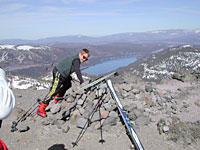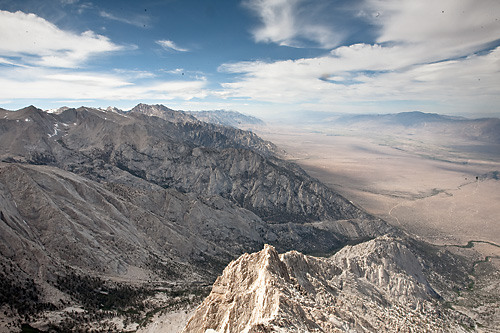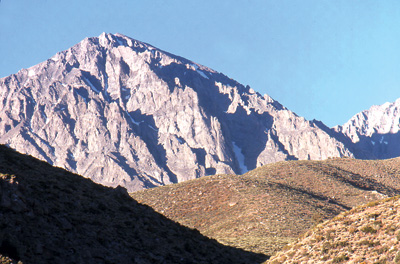- Tahoe’s Nevada Beach Tops the List of Hard-to-Book Campgrounds - 07/17/2024
- Cannabis Watershed Protection Program Cleans Up Illegal Grow Sites - 07/10/2024
- French Fire - 07/05/2024
Story & Photos by Craig Dostie, Publisher
of Couloir and Telemark Skier magazines
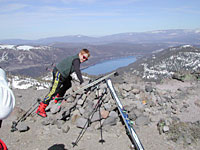
Ever since I fell in love with Deb’s kids I’ve wanted to take them into the backcountry. Our first foray became what Deb and I commonly refer to as “The Quarter Mile Epic.” We knew enough to set the bar low, but we still had inflated expectations of what the kids could handle.
The goal was to take a short, cross-country tour along a mellow stream to the edge of a slope, then go sledding. Jordan was five, so we strapped his feet to cheap cross-country skis with a waxless pattern. Braiglee was only 2-1/2, so we pulled her on a sled. Deb and I used skis with skins. From a performance standpoint, Jordan was odd man outand we heard about it for the full quarter mile.
We tried to help and coach him along, but the grip of his waxless-pattern skis was no match for our skins, even on a mere 2-degree incline. Deb ended up pulling Jordan the final 100 yards in the sled, while Braighlee rode on my back. After lunch, we went sledding and the emotional trials of the ski in fadeduntil we had to glide out.
“How come she gets to ride in the sled?”
“These skis are stupid!”
“I want to ride in the sled!”
After that episode, we decided to let the memory fade and work on basic ski skills until the kids showed their own interest in going backcountry.
Fast forward five years… Jordan and Braighlee have been baptized in both steep downhill skiing and powder. In fact, they have become pre-pubescent powder snobs, having been spoiled with a high percentage of waist-deep powder days. Let’s face it when you’re only four feet high, waist deep is easier to achieve.
At age 11, Jordan had a chance to join the Couloir randonnee test team on a quick out-of-bounds run at Sugarbowl. He didn’t complain once, whether on the skate line across the ridge or on the side-stepping climb back up. I think he was psyched to be “hangin’ with the boys.” He handled a quick traverse on a 60-degree face without flinching. It had me nervous, because a slip there could have meant sliding into rocks. But he nailed it. And, unlike the adults in the crew, he made sure he got some air time, launching off a few wind-scoured ridges. He didn’t stick the landings, but he didn’t get hurt either.

It was a calculated bit of pride I planted in him, and more than once in the next week Jordan made sure Braighlee knew he was expert enough to go into the backcountry and she was not. Then we proposed a backcountry trip at dinner and the kids agreed — enthusiastically!
The tour was to be short and sweet; a simple loop up Mt. Judah next to Sugarbowl. It would require only 500 vertical feet of climbing, and we brought lots of snacks to accommodate lots of breaks.
We started out with a few warm up runs in-bounds at Sugarbowl, then caught our final chairlift ride to the top of Mt. Lincoln. From there we skied down the first pitch to the end of Crowley’s Run, and then kept schussing straight out of bounds.
It was late morning, so the snow was already becoming over ripe corn on south and east faces. This would make excellent gripping snow for the ridge climb we had planned.
We stopped and put climbing skins on both kids’ skis and popped touring adapters into Braighlee’s skis. Braighlee began to tromp around with skins on her feet for the first time while I helped Jordan learn how to release the heel on his Ramer Classic touring binding.
“This is rad,” she exclaimed! Deb and I looked at each other and smiled.
I didn’t bother giving the kids details on how to “properly” skin, choosing to wait until they had a few minutes of sensory experience first. Within five minutes, we had our first technical difficulties, one right after the other. Braighlee managed to slide into a tree well. Once extricated, she popped out of her binding. Then we had a short downhill that gave them both fits due to the sliding resistance of skins. But we got through those trials with minimal whining.
From here on, I hoped it would be a steady, mellow, uneventful climb. After 50 vertical feet though, we heard signs of trouble.
“I’m hungry,” Braighlee moaned. Oh no, I thought, here we go.
“Okay, we can stop,” I said, “but how ‘bout we keep moving just another 20 feet or so to where it’s shady, okay?” I feared we would have to continue at this pace, stopping every 50 vertical feet.
We stopped under the shade of a sugar pine, munched on Zone bars and turkey jerkey, and swigged some water. Before we got too comfortable, Deb took the lead for the next mellow stretch.
A mere 50 vertical feet and Braighlee whined, “Can we go downhill now?”
“No, we need to keep going,” I said, trying to sound encouraging. “We’re almost half way there already. All we have to do is climb up a few more feet and we’ll be halfway there.”
“Okay,” she said, “but these stupid things keep coming off.” In a hundred feet or so her boots had popped out of the touring adapters three times. They would have held better if the boots were only a half-size larger. I couldn’t help but be sympathetic, but had no way to fix the problem, so I just prayed it would hold the rest of the way.
Then luck smiled upon us.
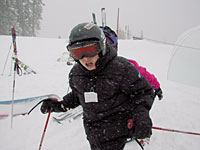
“Hey Craig, can I put on these things now?” Jordan asked. He was talking about the climbing pegs on his bindings; he wanted to swivel them into the high position. It was good timing to do so because there was a short steep pitch ahead of us.
I showed him how to swivel the pegs with his ski poles. “Now when you go steep, you need to lean back, not forward, for your skins to grip. Okay Jordan? And if you start to slip, lean back and put all your weight on your heels.”
I wasn’t sure if he was listening, but he seemed to get it because he just pointed those tips straight up the 20-degree pitch and motored up.
“I want to do that!” Braighlee exclaimed.
So we flipped up the climbing posts for Braighlee and she was off, chasing her brother all the way to the summit. We didn’t hear another whine until the snow ran out, a mere 100 feet from the wind-scoured summit of Mt. Judah.
We scrambled over rocks to the summit, a snowless moonscape. Only 50 feet leeward, however, the snow was still 20 feet deep, and arched over the east face of Judah in a soggy, drooping cornice.
After a leisurely lunch of cheese, crackers and fruit, we clipped back in to our skis and traversed across the summit ridge. It was now mid-afternoon. The sun was beginning to take its toll, and we had to get down soon or risk an injury in mush.
Gravity had recently taken a bite out of the cornice beneath us. An avalanche left a 50-foot gap along the ridgeline and littered the slope below with several refrigerator-sized blocks of snow.
After this visual tutorial on the power of avalanches, we continued traversing, then dropped back to the groomed runs underneath the Judah lift. The slope was steep and the snow mushy, but the kids had no trouble. Since this lift had closed a week earlier, we enjoyed the final run to the car on perfect corn snow as though we were still in the backcountry.
The tour took us four hours. Most folks do the climb within 30 minutes; we took two hours. But our agenda wasn’t maximizing vertical; it was creating smilesthe kind that last.
Our success was validated on the drive home. Old Highway 40 is a scenic route beneath the north face of Donner Peak. It is not a major peak in any mountaineer’s book, but it has some classic, sketchy ski terrainsteep slopes peppered with rocks and cliffs, and only a few lines that connect top to bottom. The road provides great views of one the area’s classic tours, the Lake Run, a superb descent down Mt. Judah’s east face to Donner Peak, followed by a final pitch of 1,300 vertical feet to the west end of Donner Lake. That last pitch makes every avid backcountry skier and rider drool. As this slope fixed our eyes, we heard confirmation that our trial tour had ignited their interest in earning their turns.
“Can we do that?”
Deb and I exchanged a knowing grin. “Oh yeah, we can do that…
NEXT YEAR!”

